One
of the few prisoners who saw the Jewish people die and
lived to tell about it, Filip Müller has written one
of the key documents of the Holocaust: Eyewitness
Auschwitz, or Auschwitz inferno : the testimony
of a Sonderkommando. Filip Müller, a twenty years
old Jew, came to Auschwitz with one of the earliest
transports from Slovakia in April 1942. A month later,
he found himself inside Crematorium II of Auschwitz,
ordered to undress the bodies of the dead, and load
them into the ovens.
Very
few of the hundreds of thousands people who entered the
crematorium survived. One of them was Filip Müller.
The following are his firsthand account of three years
in the gas chambers of Auschwitz:
"Every
day we saw thousands and thousands of innocent people
disappear up the chimney. With our own eyes, we could
truly fathom what it means to be a human being. There
they came, men, women, children, all innocent. They
suddenly vanished, and the world said nothing ..
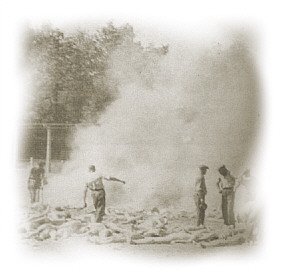
Auschwitz Inferno
At
the entrance was a signboard, and written on it
in several languages the direction: To the baths
and disinfecting rooms.The ceiling of the
changing room was supported by concrete pillars to
which many more notices were fixed, once again
with the aim of making the unsuspecting people believe
that the imminent process of disinfection was of
vital importance to their health. Slogans like Cleanliness
brings freedom or One louse may kill you
were intended to hoodwink, as were numbered clothes
hooks fixed at a height of 1.50 meters.
Down
the length of the room concrete pillars supported the
ceiling. However, not all the pillars served this
purpose: for there were others, too. The Zyklon-B gas
crystals were inserted through openings into
hollow pillars made of sheet metal. They were
perforated at regular intervals and inside them a
spiral ran from top to bottom in order to ensure as
even a distribution of the granular crystals as
possible. Mounted on the ceiling was a large number of
dummy showers made of metal. These were intended
to delude the suspicious on entering the gas chamber
into believing that they were in a shower-room.
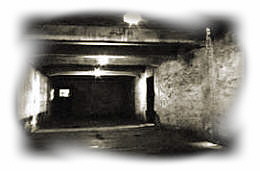
The gas chamber
..
we had not been waiting long when a large number of
people began to stream through the open gate, the
majority of them dressed in dark clothes. On the right
side at chest height they all wore the yellow Star of
David. By and by the entire yard became crowded with
these people who were talking to each other in Polish
or Yiddish. Most were middle-aged, but there was a
sprinkling of old men and women and also of children
among them. They were rather out of breath as if they
had been made to run all the way. Last to arrive was a
group of aged women who had been unable to keep up
with the younger people and who came staggering in on
the point of complete exhaustion.
Once
the stragglers were inside the gate was shut. The
uniformed executioners now stepped in front of the
waiting apprehensive crowd of several hundred. As
though at a signal they began to harangue them, waving
their truncheons about and ordering them to take their
clothes off at once. The people were dazed with fear.
Clearly they suspected something dreadful was to
befall them, but they could see no reason why they
ought to undress out here in the yard, women in front
of men and vice versa.

Piles of the victims' glasses
However,
the SS men, anxious to give them no time to think,
kept shouting: 'Come on, come on! Get undressed!
Get a move on! Come on! Come on! Get undressed!'
At last I tumbled to what was going on. One of SS men
must have had the bright idea that it was more
expedient to send these people to their doom naked.
For then the irksome task of undressing them after
their death would be avoided. Besides, if they
undressed while still alive, their clothes would not
be torn because they would think that they would need
them again.
Today
this new procedure was to be tried out for the first
time. However, it did not quite work out according to
plan. In the frightened and embarrassed faces of the
men and women assembled in the yard there was fear and
mistrust. Although unaware of what awaited them, they
sensed the seriousness and danger of their situation.
Most of the men reacted to the threats and shouts by
slowly beginning to undo the collars of their shirts,
while the women bent down and, greatly embarrassed,
undid their shoe-laces. All this took a very long
time: it was not at all the efficient operation the SS
men had envisaged.
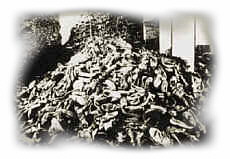
Piles of the victims' shoes
In
a corner next to the gate I noticed a young woman and
her child. Her lips tightly pressed together looked
like a scar. She gazed at her small daughter then,
stroking her, she slowly undressed her. Older children,
as alarmed as their parents, began slowly to take off
their clothes. Meanwhile the representatives of the SS
hierarchy stood on the earthworks which had been
thrown up on the roof of the crematorium. From there
they had a bird's eye view of what was going on. At
first they did not intervene, leaving everything to
their minions. But the alarm and disquiet of the
people grew apace as did their fear of the danger they
could sense: they were taking off their clothes with
great deliberation in order to gain time.
The
brutal conduct of the SS surpassed their worst fears.
They felt instinctively that they were in great danger
and began to talk among themselves. In the yard there
was a humming as in a beehive. Once it dawned on the
SS men that their brilliant plan of deception was in
jeopardy they flung themselves wildly into the crowd,
wielding their truncheons indiscriminately and yelling:
'Come on, come on! Get undressed! Faster,
faster!'
The
effect was startling. The brutal action of the SS men
had completely unnerved the people. They were confused,
frightened, unable to communicate with each other and
incapable of thinking. As the SS men persisted in
their rampaging, the crowd was seized by panic. Even
their passive resistance was now broken and they did
what was being beaten into them again and again: 'Come
on! Get undressed! Come on! Faster! Get a move on!

Holocaust victims
Men,
women and children were now tearing their clothes off,
helping each other to dodge the blows, and in no time
at all they were all standing there naked, each with a
small heap of clothes piled in front of them. Once
again I watched the young mother in the corner by the
gate. Carrying her child on her arm she, too, was now
undressed. She was not ashamed of her nakedness, but
the premonition that perhaps she had undressed her
child and herself for the last time put her into a
state of helpless submission to God's will.
Two
of the SS men took up positions on either side of the
entrance door. Shouting and wielding their truncheons
like beaters at a hunt, the remaining SS chased the
naked men women and children into the large room
inside the crematorium. All that was left in the yard
were the pathetic heaps of clothing which we had to
gather together to clear the yard for the second half
of the transport. We removed suit-cases, rucksacks,
clothes and shoes and piled them higgledy-piggledy in
a great heap in a corner. Then we covered everything
with a large tarpaulin ..
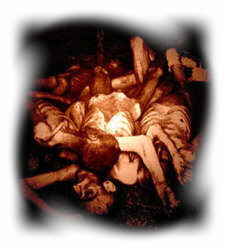
..
two disinfecting operators climbed on the
roof, carrying sealed tins manufactured by the
Degesch Company. They chatted leisurely, smoking a
cigarette.Then, on signal, each of them walked to
a one foot high concrete shaft, donned a gas mask,
took off the lid, opened the tin, and poured the
pea-sized contents into the shaft. They closed the
lids, took off their masks, and drove off.
After
a while I heard the sound of piercing screams,
banging against the door and also moaning and wailing.
People began to cough. Their coughing grew worse
from minute to minute, a sign that the gas had started
to act. Then the clamor began to subside and to
change to a many-voiced dull rattle, drowned now and then
by coughing. Ten minutes later all was quiet.

..
As
the doors opened, the top layer of corpses tumbled out
like the contents of an overloaded truck when the
tail-board is let down. They were the strongest who,
in their mortal terror, had instinctively fought their
way to the door, the one and only way out, had there
been even the remotest possibility of getting out ...
the bottom layer of corpses always consisted of
children as well as the old and the weak, while the
tallest and strongest lay on top.
No
doubt the ones on top had climbed up there over the
bodies already lying on the floor because they still
had the strength to do so and perhaps also because
they had realized that the deadly gas was spreading
from the bottom
upwards ... many had their mouths wide open, on their
lips traces of whitish dried-up spittle. Many had
turned blue, and many faces were disfigured almost
recognition from blows.
Almost
all of them were wet with sweat and urine, filthy with
blood and excrement, while the legs of many women were
streaked with menstruel blood.
Among
them lay the bodies of pregnant women, some of whom
had expressed the head of their baby just before they
died ..."
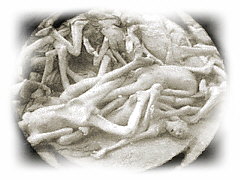
Auschwitz
became the killing centre where the largest numbers of
European Jews were killed. After an experimental
gassing there in September 1941 of 850 malnourished
and ill prisoners, mass murder became a daily routine.
By mid 1942, mass gassing of Jews using Zyklon-B began
at Auschwitz, where extermination was conducted on an
industrial scale with some estimates running as high
as three million persons eventually killed through
gassing, starvation, disease, shooting, and burning
...
Near
the end of the war, in order to cut expenses and save
gas, cost- accountant considerations led to an order
to place living children directly into the ovens of
Auschwitz or throw them into open burning pits.
In
Claude Lanzmann's Shoah, Filip Müller
recalls the moment in Crematorium II when the
prisoners from the Czech Family Camp were to be killed
and he chose to join them in the gas-chamber:
"As
soon as they left the vans, the beatings began. When
they entered the undressing room, I was
standing near the rear door, and from there I
witnessed the frightful scene. The people were
bloodied. They knew where they were ... They were in
despair. Children clung to each other. Their mothers,
their parents, the old people all cried, overcome with
misery ...
Yes,
the violence climaxed when they tried to force the
people to undress. A few obeyed, only a handful. Most
of them refused to follow the order. Suddenly, like a
chorus, they all began to sing. The whole undressing
room rang with the Czech national anthem, and the
Haiikvah. That moved me terribly, that ... was
happening to my countrymen, and I realized that my
life had become meaningless. Why go on living? For
what?
So
I went into the gas chamber with them, resolved to die
with them. Suddenly, some who recognized me ... They
looked at me and said, right there in the gas chamber
... 'So you want to die! But that is senseless. Your
death won't give us back our lives. That's no way. You
must get out of here alive, you must bear witness to
our suffering, and to the injustice done to us."
Filip
Müller miraculously survived to become a source-one
of the few victims who saw the Jewish people die and
lived to tell about it - a
detailed description of life in Hell’s inmost circle
..